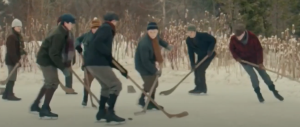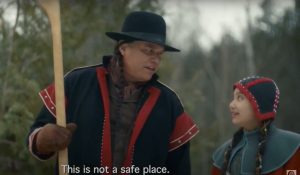4
These are difficult stories. We bear witness in this chapter to the role of sport in furthering the settler colonial projects throughout Turtle Island. Here are some supports to access in the community and from a distance:
First Peoples House of Learning Cultural Support & Counselling
Niijkiwendidaa Anishnaabekwag Services Circle (Counselling & Healing Services for Indigenous Women & their Families) – 1-800-663-2696
Nogojiwanong Friendship Centre (705) 775-0387
Peterborough Community Counselling Resource Centre: (705) 742-4258
Hope for Wellness – Indigenous help line (online chat also available) – 1-855-242-3310
LGBT Youthline: askus@youthline.ca or text (647)694-4275
National Indian Residential School Crisis Line – 1-866-925-4419
Talk4Healing (a culturally-grounded helpline for Indigenous women):1-855-5544-HEAL
Section One: History
A) The Residential School System
Exercise 1: Notebook Prompt
We are asked to honour these stories with open hearts and open minds.
Which part of the chapter stood out to you? What were your feelings as you read it? (50 words)
| What stood out to me was how sports were used not just for recreation, but as a tool of control and assimilation. Yet, despite that, students created moments of joy, pride, and resistance through these activities. It made me feel both heartbroken for their suffering and inspired by their strength and resilience. |
B) Keywords
Exercise 2: Notebook Prompt
Briefly define (point form is fine) one of the keywords in the padlet (may be one that you added yourself).
|
C) Settler Colonialism
Exercise 3: Complete the Activities
If colonialism is typically temporary, settler colonialism is long-lasting
In contrast with colonialism, in settler colonialism, settlers form deep attachments to the land*.
2. ) Settler colonialism often grows out of colonialism.
True or False
3. ) What is the role of sport in settler colonial projects?
-
Appropriating the body cultures of Indigenous peoples.
-
Controlling the bodies of indigenous peoples
-
Allowing Indigenous peoples to preserve their traditions.
Exercise 4: Notebook Prompt
Although we have discussed in this module how the colonial project sought to suppress Indigenous cultures, it is important to note that it also appropriates and adapts Indigenous cultures and “body movement practices” (75) as part of a larger endeavour to “make settlers Indigenous” (75).
What does this look like? (write 2 or 3 sentences)
| Settlers would adopt and adapt Indigenous cultural practices like sports, games, and movement to create a sense of belonging and identity in the land they colonized. At the same time, they often erased or ignored the cultural meaning behind these practices, using them to make themselves appear Indigenous while excluding actual Indigenous Peoples. This was part of a larger colonial strategy to control Indigenous bodies and claim the land as their own. |
D) The Colonial Archive
How does the archive play “an essential role in reinforcing colonial narratives about Indigenous-settler relations?”
1. Most photos were taken for official reporting reasons and therefore “connote meanings tied to and objectives” (51).
2. Images curated to suggest “a sheltered and productive school environment” that was “efficient, well-managed, and orderly” created a for readers who are invited to superimpose their own educational experiences onto what they see” (51)
3. Widely circulating generic images convey a sense that faces are and erase individual Indigenous (61)
Exercise 5: Complete the Activities
Section Two: Reconciliation
A) Reconciliation?
Exercise 6: Activity and Notebook Prompt
Visit the story called “The Skate” for an in-depth exploration of sport in the residential school system. At the bottom of the page you will see four questions to which you may respond by tweet, facebook message, or email:
How much freedom did you have to play as a child?
What values do we learn from different sports and games?
When residential staff took photos, what impression did they try to create?
Answer one of these questions (drawing on what you have learned in section one of this module or prior reading) and record it in your Notebook.
| Residential school staff took photos of children playing sports like hockey to create the impression that the schools were happy and safe places where Indigenous children were thriving. These photos were used as propaganda to hide the harsh reality of neglect, abuse, and cultural erasure. As we learned in this module, sport was used as a tool of assimilation, teaching European Canadian values, but the photos ignored the suffering and control that happened behind the scenes. They showed smiling faces, but not the truth that for many children, sport was survival, not just play. |
B) Redefining Sport
B) Sport as Medicine
Exercise 7: Notebook Prompt
Make note of the many ways sport is considered medicine by the people interviewed in this video.
| Sport is considered medicine in different ways by the people interviewed in the video. Aiden Baker shares that lacrosse is a gift from the Creator and has always been his medicine growing up. It helped him through life’s challenges and gave him purpose and pride. His grandfather, a residential school survivor, also found healing in sport, especially lacrosse. Chief Robert Joseph remembers the trauma of residential school but says that moments of sport brought happiness and connection. William Nahini describes boxing as a way to stay strong and focused, even when he was taken to perform in front of inmates as a child. Lucy Kuptana talks about skiing in extremely cold conditions and how sports became a way to endure hardship. Another speaker says sport gave them a release and helped them deal with school and life. These experiences show how sport helped people cope, heal, and stay grounded in their identities. |
C) Sport For development
Exercise 7: Notebook Prompt
What does Waneek Horn-Miller mean when she says that the government is “trying but still approaching Indigenous sport development in a very colonial way”?
| Waneek Horn-Miller means that although the government is putting money and effort into supporting Indigenous sport, they are still controlling it based on non-Indigenous ideas and systems. Instead of working with Indigenous communities to understand their unique needs, values, and ways of organizing sport, the government continues to apply the same structures that were created through colonialism. This limits the ability of Indigenous people to lead their own sport programs in ways that reflect their cultures, traditions, and ways of coming together as a community. |
Exercise 8: Padlet Prompt
Add an image or brief comment reflecting some of “binding cultural symbols that constitute Canadian hockey discourse in Canada.” Record your responses in your Notebook as well.
| I chose a still from Anne with an E where the children are playing hockey, first because it captures the nostalgic and cultural image of hockey as a simple and joyful part of growing up in Canada. Secondly, because it was one of the first times that i realized, because of this scene, how much colonial settlers relied on Indigenous peoples, even in small ways. It was not just that they made the sticks, settlers took over the game itself, changed it, and turned it into something they could claim and profit from. At the same time, Indigenous people were still excluded and treated unfairly. That contradiction really stood out to me.
https://www.youtube.com/watch?v=0fHAaDKkZuk |


Section Three: Decolonization
Please see the major assignment for this half of the term in the final section of this chapter.
Call to Action 87 from the Truth and Reconciliation Commission calls on all levels of government to work with Indigenous peoples and organizations to provide public education that tells the national story of Indigenous athletes in history. This call has been partly answered through several national efforts aimed at increasing visibility and recognition of Indigenous excellence in sport. One key example is the Tom Longboat Awards, which recognize outstanding Indigenous athletes from across Canada. These awards were first created in 1951 and are now led by the Aboriginal Sport Circle. They honour athletes for their achievements and provide a platform to highlight Indigenous success and resilience through sport. The awards help educate Canadians about the important contributions Indigenous athletes have made over time and the barriers they have overcome.
Canada’s Sports Hall of Fame has also taken meaningful steps by increasing the representation of Indigenous athletes in its exhibits and launching digital education resources in 2021. These include profiles of athletes like Alwyn Morris, who won Olympic gold, and Waneek Horn Miller, a trailblazer in water polo. These tools are used in classrooms and public settings to promote understanding and appreciation of Indigenous sporting history. Communities and individuals especially settlers can contribute to this work by actively learning about Indigenous athletes and sharing their stories with others. They can support Indigenous-led sport programs, encourage schools to include this history in the curriculum, and attend events that celebrate Indigenous sport and culture. By doing this, people can challenge stereotypes, help shift dominant narratives, and support reconciliation through education and respect. Telling these stories is about more than sport. It is about honouring Indigenous voices, addressing historic erasure, and showing that Indigenous peoples have always been a powerful part of Canadian sport and society. This work is ongoing and must be done together.

